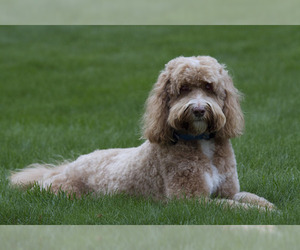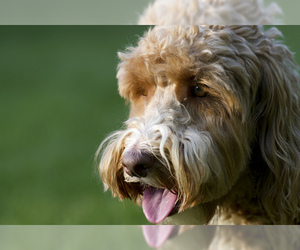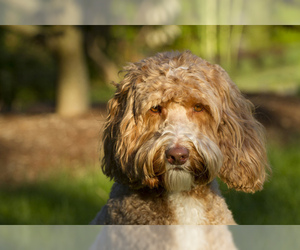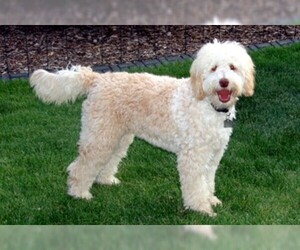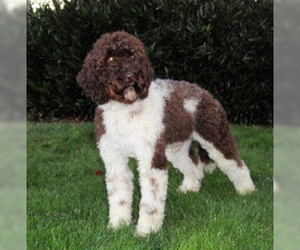
All about Australian Labradoodle dog breed
A.K.A. :Australian Cobberdog, Cobberdog, Labradoodle, Aus Labradoodle, ALD, Aussie Labradoodle
Size
Grooming requirements
Exercise requirements
Good with other dogs
Watchdog ability
Energetic
Training requirements
Playful
Affectionate
Good with other pets
Good with children
Good with strangers
Winter
Summer
Healthiness
Protective
Life Span
| Pure Breeds | Member |
| Breeds A - Z | A |
| Breeds by Group | Companion Non-Sporting |
| Breeds by Trait | Good With Kids Hypoallergenic Low Shedding Smartest Dog Breeds |
| Overview: | The Australian Labradoodle, a delightful companion, originated in Australia with the deliberate goal of creating a hypoallergenic guide dog. This breed is a carefully curated blend of several others, including the Poodle, Labrador Retriever, English Cocker Spaniel, American Cocker Spaniel, Irish Water Spaniel, and Curly Coated Retriever, contributing to its diverse gene pool and robust health. Physically, they come in three sizes – miniature, medium, and standard – sporting a single non-shedding, allergy-friendly coat that can be fleece or wool, often wavy or curly, and in a myriad of colors. Temperamentally, they are renowned for their intelligent, intuitive, and affectionate nature, making them highly trainable and wonderful family pets. Their gentle demeanor and eagerness to please mean they generally get along well with children and other animals. While adaptable, their moderate exercise needs mean regular walks and playtime are essential. They can thrive in apartment living provided they receive adequate stimulation and outdoor activity. Regarding health, reputable breeders screen for common conditions like hip and elbow dysplasia, eye diseases, and certain genetic disorders, ensuring the continued well-being of this beloved breed. |
F.A.Q.
All You Need to Know About the Australian Labradoodle Breed
The Australian Labradoodle is a delightful, intelligent, and highly sought-after companion, originating in Australia from a carefully selected combination of breeds, including the Labrador Retriever, Poodle, and American and English Cocker Spaniel. Renowned for their friendly and intuitive temperament, they are exceptionally good with children and other pets, making them ideal family dogs. Physically, they boast a low-shedding, allergy-friendly coat (fleece or wool) and come in a variety of sizes (miniature, medium, standard) and colors. While adaptable, their moderate exercise needs mean daily walks and playtime are essential. They can thrive in apartments with sufficient outdoor activity, but a yard is a bonus. Regular grooming, including brushing and occasional professional trims, is crucial to prevent matting. Generally healthy, potential adopters should be aware of common health screenings for hips, elbows, and eyes. Their eager-to-please nature makes them highly trainable, perfect for first-time owners.Australian Labradoodle weight generally ranges from 15 to 65 pounds, with size categories often dictating the typical healthy weight for Australian Labradoodle.
- Miniature Australian Labradoodles: 15-25 pounds
- Medium Australian Labradoodles: 30-45 pounds
- Standard Australian Labradoodles: 50-65 pounds
Curious about the Australian Labradoodle height? We've got the scoop on their average size!
The average height of an Australian Labradoodle, measured at the shoulder (withers), typically ranges from 14 to 24 inches. This breed comes in three recognized sizes:- Miniature Australian Labradoodle: Generally 14 to 16 inches tall.
- Medium Australian Labradoodle: Usually 17 to 20 inches tall.
- Standard Australian Labradoodle: Typically 21 to 24 inches tall.
The Australian Labradoodle comes in a stunning array of Australian Labradoodle colors, offering something for every preference. Officially recognized Australian Labradoodle colors by breed clubs (though the Australian Labradoodle is not AKC recognized) include solid colors like chocolate, cream, caramel, red, black, apricot, and parchment. Parti-colored variations are also common, featuring a solid color with white markings, often referred to as parti or phantom (a specific pattern with points of a different color). Rare coat types and exotic Australian Labradoodle variations include brindle, a striped pattern; sable, a coat with darker tips on lighter hair; blue, a dilute black; and lilac (also called lavender or Isabella), a dilute chocolate. While these unique colors are highly sought after and can influence pricing, it's important to remember that coat color is secondary to health and temperament.
The Australian Labradoodle personality is renowned for being joyful, intelligent, and highly social. These dogs are exceptionally friendly, displaying an eagerness to please that makes them wonderful companions. Their loyalty to their families is profound, often forming strong bonds. They are generally very sociable, thriving on interaction with people and other animals. While adaptable, they are energetic and benefit from regular exercise; however, their moderate size and calm indoor demeanor, especially after adequate activity, can make them adaptable to apartment living provided their needs for mental and physical stimulation are met. With children, they are typically gentle and patient, making them excellent family pets. They also tend to get along well with other pets, often displaying a playful and non-aggressive demeanor. The overall temperament of Australian Labradoodle is one of an affectionate, intuitive, and remarkably trainable dog, eager to participate in family life.
The Australian Labradoodle temperament is famously delightful, making them exceptional companion dogs. They are inherently friendly, sociable, and eager to please, forming strong bonds with their families. Known for their unwavering loyalty, they thrive on interaction and being part of the action.These intelligent dogs are generally adaptable, capable of adjusting to various living situations, including apartment living, provided they receive sufficient exercise and mental stimulation. They are typically wonderful with children, exhibiting patience and a playful nature. Their high sociability extends to other pets, with whom they usually coexist peacefully.While generally good-natured, their intelligence can sometimes lead to a touch of stubbornness, especially during training, but they respond well to positive reinforcement. They can also be a bit sensitive to harsh corrections, preferring a gentle, consistent approach. Overall, the Australian Labradoodle personality traits point to a joyful, affectionate, and intelligent companion for a loving home.
Australian Labradoodle Care: Your Guide to a Happy, Healthy CompanionAustralian Labradoodle care involves consistent daily maintenance to ensure a well-adjusted and healthy pet. This breed is known for its hypoallergenic coat and generally good temperament, but requires attention to several key areas.Grooming Needs: Australian Labradoodles are not low-energy dog breeds in terms of grooming. Their non-shedding, often curly or wavy coats require regular brushing, typically 2-3 times a week, to prevent matting and tangles. Professional grooming, including bathing and clipping, is recommended every 6-8 weeks to maintain coat health and hygiene. Pay special attention to areas prone to matting, such as behind the ears and under the legs.Exercise Limitations: Despite their playful nature, Australian Labradoodles are generally moderate-energy dogs. They require daily exercise, typically 30-60 minutes of walks or play, to stay physically and mentally stimulated. While they enjoy outdoor activities, they are not suited for extreme endurance sports and should not be over-exercised, especially in hot weather. They are susceptible to heatstroke due to their thick coats; always provide access to water and shade during activity.Dietary Considerations: A high-quality, balanced diet appropriate for their age, weight, and activity level is crucial for how to care for a Australian Labradoodle. Consult your veterinarian for specific recommendations. Weight management is important as they can be prone to obesity, which exacerbates other health issues. Avoid overfeeding and limit treats.Wrinkle and Ear Cleaning: While not a brachycephalic breed, regular ear cleaning is essential to prevent infections, especially for dogs with floppy ears. Check ears weekly for redness, odor, or discharge, and clean as recommended by your vet. While Australian Labradoodles don't typically have facial wrinkles, maintain good hygiene around the mouth area to prevent skin irritation.Climate Sensitivity: Australian Labradoodles can be sensitive to extreme temperatures. Their thick coats offer some protection in colder climates but can lead to overheating in hot, humid weather. Always provide shade, fresh water, and avoid strenuous exercise during the hottest parts of the day.Common Health Concerns & Health Tips for Australian Labradoodle: Be aware of common health concerns such as skin issues (allergies, hot spots), which can be managed with proper grooming and diet. Dental care is paramount; brush teeth regularly and provide dental chews to prevent plaque buildup and gum disease. Routine veterinary check-ups are vital for early detection and prevention of common breed ailments like hip and elbow dysplasia, eye conditions, and certain cancers. Stay proactive with vaccinations and parasite control. By addressing these Australian Labradoodle care aspects, you can ensure a long, healthy, and happy life for your furry friend.
Australian Labradoodle Activity Level: A Balanced CompanionThe Australian Labradoodle activity level is generally moderate, making them versatile companions for a range of households. They possess a delightful blend of playful energy and a calm demeanor, balancing short bursts of enthusiastic activity with long periods of relaxed rest.Typical Energy Levels: Australian Labradoodles are not typically hyperactive, nor are they couch potatoes. They enjoy engaging in activities with their families but are also content to settle down and relax indoors. Their energy levels are manageable, making them adaptable to various lifestyles.Daily Exercise Needs: To maintain their physical and mental well-being, Australian Labradoodles require daily exercise. This usually translates to at least 30-60 minutes of moderate activity per day. This can include:* Daily walks: Leashed walks in the neighborhood or local park are essential.* Playtime in a secure yard: Fetch, tug-of-war, or simply romping around will satisfy their need to move.* Mental stimulation: Puzzle toys, training sessions, or interactive games are also beneficial.Playtime Preferences: Australian Labradoodles love to play! They enjoy engaging with their human families and are often keen on retrieving games. Their intelligent and eager-to-please nature makes them excellent candidates for learning new tricks and participating in dog sports like agility or obedience, if their family is so inclined.Limitations Due to Brachycephalic Anatomy: It's important to note that while the Australian Labradoodle's snout is not as extremely short as some brachycephalic breeds, some individuals may still have slightly shorter muzzles. This means they can be more susceptible to overheating, especially in hot weather or during intense exercise. Therefore, it's crucial to:* Avoid strenuous activity during the hottest parts of the day.* Always provide access to fresh water.* Monitor for signs of overheating such as excessive panting, lethargy, or drooling.Suitability for Households:* Active Families: Yes, Australian Labradoodles are suitable for active families who enjoy daily walks, playtime, and perhaps even some outdoor adventures. They thrive on interaction and being part of family activities.* Low-Energy Households: While they are adaptable, a completely sedentary lifestyle would not be ideal. They do require regular exercise. However, for households that can commit to consistent daily walks and indoor play, they can be a wonderful fit. They are excellent at adjusting their energy to match their family's pace, often content to snooze at your feet after their exercise needs are met.In summary, for those wondering how active are Australian Labradoodles, they offer a fantastic balance of energy and calmness, making them well-suited for families seeking an engaging yet manageable canine companion.
Breed Breakdown: What Experts Say About the Australian Labradoodle
I would rate the Australian Labradoodle's "Size" trait a 6 out of 10.While not a tiny dog, the Australian Labradoodle is consistently bred in three distinct size categories: Miniature, Medium, and Standard. This range prevents it from being considered truly large like a Great Dane or Irish Wolfhound, but also not consistently small like a Chihuahua or Pomeranian. The Miniature typically weighs between 15-25 lbs and stands 14-16 inches tall, making them quite manageable. The Medium size is around 30-45 lbs and 17-20 inches, a comfortable medium. The Standard, at 50-65 lbs and 21-24 inches, is the largest but still within a very common range for companion breeds. Their body structure is generally athletic and well-proportioned, not bulky or delicate.This versatility in size means a Miniature or even a smaller Medium Australian Labradoodle could be quite well-suited for apartment living and travel, as they don't require vast amounts of space. However, a Standard Australian Labradoodle, while still manageable in many homes, would certainly appreciate a bit more room and might be less ideal for very cramped apartments or frequent air travel due to their larger crate requirements and physical presence. Overall, their varied but generally moderate sizing places them firmly in the middle to slightly above average category when compared to the vast spectrum of companion dogs, making a 6 an appropriate rating.
Rating: 8The Australian Labradoodle's grooming requirements are notably high-maintenance, warranting an 8. While often touted as low-shedding, their signature fleece or wool coats are prone to matting and require consistent attention. Daily to every-other-day brushing is crucial to prevent painful tangles and mats that can lead to skin irritation and infections. Professional grooming every 6-8 weeks is typically necessary for a proper trim and dematting, which can be expensive. Although they are not excessive droolers and lack prominent skin folds, their floppy ears need regular cleaning to prevent ear infections, and their fast-growing nails require frequent trimming. While generally healthy, some individuals can be prone to allergies, which may manifest as skin issues and necessitate specialized shampoos or dietary changes, further adding to grooming complexity and care. Compared to many other companion dogs, the Australian Labradoodle is far from a "wash and wear" breed and demands significant time and effort to maintain their coat and overall well-being.
I would rate the Australian Labradoodle's exercise requirements at a 7 out of 10.Australian Labradoodles are energetic and intelligent dogs that generally require a moderate to high amount of daily activity to stay healthy and well-behaved. They possess a good deal of stamina and enjoy sustained movement. While not as relentlessly driven as some working breeds, they are far from "couch potatoes" and can become destructive or anxious if their exercise needs aren't met. Daily activity recommendations usually include at least 60-90 minutes of vigorous exercise, which can be broken up throughout the day. This could involve long walks, jogging, active playtime (fetch, tug-of-war), or even dog sports like agility. Their energy levels are typically high, especially in their younger years, and they thrive on engaging activities that challenge both their bodies and minds. They generally have no respiratory limitations, as they are not a brachycephalic breed. They are well-suited for a variety of exercises and benefit greatly from structured routines that include both physical exertion and mental stimulation. They don't thrive with minimal activity and absolutely require consistent, engaging exercise to prevent boredom, maintain a healthy weight, and manage their zest for life.
I'd rate the Australian Labradoodle's "Watchdog Ability" at a 5 out of 10.While generally alert and aware of their surroundings, the Australian Labradoodle isn't typically bred for strong protective or territorial instincts in the way a dedicated guard dog breed would be. They are intelligent and will often bark to signal the arrival of visitors or unusual sounds, providing a good "early warning system." This initial alert, however, is more of a "someone's here!" notification rather than an aggressive "stay away!" deterrent. Their friendly and social nature means they are more likely to greet an unfamiliar person with curiosity or enthusiasm rather than suspicion or hostility once that person is recognized as non-threatening by their owners. They are not usually inclined to deter intruders through aggressive displays, and their willingness to deter is generally low. They are more of a passive companion capable of providing meaningful early warnings in a home environment due to their alertness and vocalizations, but not for their protective prowess.
I'd rate the "Good with Other Dogs" trait of the Australian Labradoodle a 9 out of 10.Australian Labradoodles generally excel in canine company and are known for their naturally amiable and sociable disposition. They typically display a friendly curiosity towards unfamiliar dogs, often initiating playful interactions rather than showing apprehension or aggression. Their adaptable nature allows them to get along well with dogs of various sizes and energy levels, from boisterous large breeds to more sedate smaller companions, often matching their play style to their canine partners. While early socialization is beneficial for any breed, Australian Labradoodles tend to thrive in these experiences, readily learning appropriate dog-dog etiquette. They are rarely prone to dominance displays or aggression, preferring harmonious interactions. This makes them an excellent choice for multi-dog households, where they often integrate seamlessly and enjoy the constant companionship of other canines, finding joy in shared activities and relaxation. They generally require minimal, if any, careful introductions, often making friends quickly and easily.
I would rate the Australian Labradoodle's "Energetic" trait a 7 out of 10.Australian Labradoodles are generally a very active and playful breed. They possess a good amount of energy that requires regular outlets to prevent boredom and destructive behaviors. They typically enjoy walks, runs, playing fetch, and other interactive games. Their endurance is quite good, allowing them to participate in extended outdoor activities, and they are often enthusiastic participants in dog sports like agility or obedience. Compared to many other companion breeds, they are certainly more on the active side rather than laid-back.It's important to note, however, that while their energy is high, it's usually manageable with consistent exercise. They aren't typically "hyper" in the extreme sense like some working breeds can be if not adequately stimulated. A key factor in this breed's energy level and exercise tolerance is that they are *not* brachycephalic. The Australian Labradoodle's well-proportioned muzzle and open airways mean they do not experience the respiratory difficulties and stamina limitations that characterize brachycephalic breeds. This allows them to breathe freely and exert themselves more effectively during physical activity without the risk of overheating or respiratory distress, further contributing to their sustained energy and ability to enjoy various outdoor pursuits.
I would rate the Australian Labradoodle's "Training Requirements" a 3 out of 10.Australian Labradoodles are generally very intelligent, eager to please, and highly responsive to commands, making them remarkably trainable. They tend to have a good attention span, especially when engaged in positive and fun training sessions. Their gentle nature means they thrive on positive reinforcement and are rarely stubborn, preferring to cooperate. While consistency is always beneficial for any breed, Labradoodles pick up new commands quickly and are forgiving of occasional lapses. This breed is very beginner-friendly and excels with consistent, positive reinforcement-based training. They do well with structured routines but adapt well even without highly experienced handling.
I would rate the Australian Labradoodle's "Playful" trait a 9 out of 10.Australian Labradoodles are renowned for their effervescent personalities and genuine joy in interaction. They are naturally spirited dogs, far more inclined to be "on" and engaged than laid-back. Their typical activity level is moderate to high; while they aren't hyperactive, they definitely thrive on daily walks, romps, and mental stimulation. They absolutely adore games, whether it's a vigorous fetch session, a challenging puzzle toy, or a good old-fashioned game of tug. Their attention-seeking behavior is often expressed through bringing toys, nudging for pets, or simply following you around with an expectant wag. They respond to toys and playtime with immense enthusiasm, often exhibiting a happy "wiggle" and an eagerness to participate. This enthusiasm extends to their overall daily life, making them incredibly fun-loving and engaging companions.
I would rate the Australian Labradoodle's "Affectionate" trait a solid 9 out of 10. They are exceptionally loving and people-oriented, truly thriving on human companionship. These dogs have a strong desire to be near their family, often following them from room to room. Physical closeness is a hallmark of the breed, with many Australian Labradoodles being enthusiastic cuddlers and lap-sitters, even as adults. Their loyalty is unwavering, and they are remarkably sensitive to their owner's emotions, often offering comfort without being prompted. While intelligent and capable of independent thought, they are far from independent in the emotional sense; they are deeply bonded companion dogs who flourish when integrated into family life and given ample affection.
I would rate the Australian Labradoodle's "Good with Other Pets" trait as an 8 out of 10.Australian Labradoodles are generally known for their amiable and gentle dispositions, which naturally extends to their interactions with other animals. They typically possess a lower prey drive compared to many other breeds, making them less likely to view smaller pets like cats as prey. Their desire for companionship often means they are quite happy to include other furry family members in their activities. Resource guarding, while a potential in any breed, is not a predominant trait in well-bred Australian Labradoodles, especially with early training and management.However, the "8" rating acknowledges that while naturally sociable, they are not entirely foolproof. Like all dogs, early and consistent socialization is crucial. Introducing a puppy to various animals in a positive and controlled manner significantly enhances their ability to coexist peacefully. While generally adaptable, supervision during initial introductions and ongoing reinforcement of good manners are always recommended in a multi-pet household. They are more likely to be naturally sociable than to require extensive training to coexist, but training will certainly enhance the harmony of a multi-pet home.
I'd rate the Australian Labradoodle's "Good with Children" trait a strong 9 out of 10. They are exceptionally child-friendly. Their temperament is a key factor; they are known for being gentle, affectionate, and remarkably patient. This breed generally loves to play and is highly tolerant of the typical noise and sometimes clumsy handling that comes with children of various ages, from toddlers to teenagers. While all dogs benefit from early socialization and consistent positive reinforcement training, the Australian Labradoodle naturally possesses a calm and eager-to-please disposition that makes them inherently well-suited for family life. They thrive on companionship and often form strong bonds with children, making them a wonderful, devoted family pet with minimal specific training needed to adapt to a child-filled home, beyond basic obedience and manners.
Rating: 9The Australian Labradoodle's "Good with Strangers" trait typically rates very high due to their inherent sociable and friendly nature. They are naturally outgoing and tend to greet unfamiliar adults with enthusiasm and a wagging tail, often seeking out affection. While early socialization always enhances this trait, they generally do not require extensive training to be comfortable with strangers; it's more their default setting. They are not typically prone to excessive barking or guarding behavior with guests, preferring to welcome rather than deter. Their adaptability in public or guest-filled environments is excellent, as they usually enjoy the attention and new interactions. They thrive on being part of the an environment with people, making them exceptionally welcoming to those they haven't met before.
The Australian Labradoodle's "Winter" tolerance rates a 6. While not an Arctic breed, they possess a generally thick, often wool or fleece coat that offers good insulation. Their moderate body fat and medium size contribute to better cold retention than smaller breeds. Critically, their lack of brachycephalic anatomy means they don't have the breathing difficulties that can be exacerbated by cold air in breeds like bulldogs, reducing their risk of respiratory distress during winter exercise. However, they are not bred for extreme cold and prolonged exposure in very low temperatures could still lead to hypothermia, especially in shorter-coated individuals or those with less body fat. They can safely enjoy outdoor activities in cold climates, but like most companion dogs, they will require some special consideration in harsh winter conditions. This might include a coat or sweater for extended periods outdoors, especially in sub-freezing temperatures, and ensuring they have a warm, dry place to retreat to after play. They are generally more resilient than many short-coated or toy breeds but less so than true northern breeds.
I would rate the Australian Labradoodle's "Summer" tolerance at a 6.Australian Labradoodles generally have a moderate tolerance for summer heat. Unlike many brachycephalic breeds, they typically do not have severely shortened snouts, which significantly reduces their risk of respiratory distress in warm weather. Their ability to regulate body temperature is fair, but their dense, often fleecy or wooly coats can trap heat. This coat type means they are at a higher risk of overheating and heatstroke compared to dogs with single, short coats, especially during strenuous activity or prolonged exposure to direct sun.While they can certainly enjoy outdoor activities in the summer, these should be carefully managed. Morning and evening walks are preferable, and midday sun should be avoided. Access to shade, fresh water, and cool indoor spaces is crucial. They do require special care in summer months compared to many other companion dogs, primarily due to their coat, which necessitates more frequent grooming (especially during shedding season) to prevent matting and improve airflow, and a heightened awareness of heatstroke symptoms. While not requiring constant climate control, they certainly benefit from air-conditioned environments on very hot days and should never be left outdoors for extended periods in high temperatures.
I would rate the Australian Labradoodle's "Healthiness" trait at a 7 out of 10.While not entirely without predispositions, the Australian Labradoodle generally benefits from its hybrid vigor and the careful breeding practices established within the breed's development. Compared to many purebred dogs, they are often considered more robust and less prone to the extreme health issues sometimes seen in breeds with very limited gene pools or exaggerated physical traits. Their life expectancy is typically good for a medium-to-large dog, ranging from 12 to 15 years.However, they are not entirely immune to health concerns, and responsible breeding plays a crucial role in mitigating these. Common breed-specific issues, while not as prevalent as in some breeds, can include hip and elbow dysplasia, certain eye conditions (like progressive retinal atrophy), and occasional skin allergies. Responsible breeders diligently screen their breeding stock for these genetic predispositions, and choosing a puppy from such a breeder significantly improves the likelihood of a healthy dog.They are generally not considered high-maintenance in terms of health compared to breeds with inherent structural problems (like brachycephalic breeds struggling with breathing) or extensive grooming requirements to prevent skin issues. However, like all dogs, they require consistent preventive care, including proper nutrition, regular exercise, and routine veterinary check-ups to maintain their well-being. Their coat does require regular grooming to prevent matting, which, if neglected, could lead to skin problems. Overall, with responsible breeding and attentive ownership, the Australian Labradoodle is a generally healthy and resilient companion.
I would rate the Australian Labradoodle's "Protective" trait at a 3 out of 10.While they are exceptionally loyal and loving companions, and will certainly alert you to someone at the door with a bark, their protective instincts are generally not strong. They tend to be friendly and outgoing, even with strangers, and are far more likely to greet an unfamiliar person with a wagging tail than with suspicion or aggression. Their alert barking stems more from curiosity or a desire to communicate than from a territorial or defensive mindset. They lack the inherent territorial instincts and guardian drive of true protective breeds and are not suitable as a watchdog in the sense of deterring intruders, nor do they possess any guard dog capabilities. They are, first and foremost, companion dogs, excelling in affection and sociability rather than offering meaningful physical protection in a household setting.
I would rate the Australian Labradoodle's "Life Span" trait an 8 out of 10.Australian Labradoodles are generally considered a long-lived breed compared to many other companion dogs. Their average life expectancy typically falls within the 12 to 15-year range, and it's not uncommon for them to live even longer with good care. This longevity is largely attributed to the hybrid vigor often observed in well-bred crossbreeds, as they benefit from a broader gene pool, potentially reducing the incidence of breed-specific genetic diseases that can plague purebreds. While they can be predisposed to certain health issues like hip and elbow dysplasia, eye conditions, and Addison's disease (due to the foundational breeds), responsible breeding practices involve extensive health testing of parent dogs, significantly reducing the likelihood of passing on these genetic problems. Furthermore, their relatively moderate size, compared to very large breeds which tend to have shorter lifespans, also contributes to their longevity. With proper nutrition, regular exercise, routine veterinary care, and responsible breeding, Australian Labradoodles generally enjoy healthy and extended lives.
Australian Labradoodle Dogs for adoptionSee all dogs for adoption
Australian Labradoodle BreedersSee all breeders
Similar Dog Breeds for Australian Labradoodle
Quick Breed Selector 0 - not important, 1 - smallest, 10 - largest
Variants & Mistakes :Austrailian Labradoodle, Australian Labradoodel, Australian Labradooodle, Australian Labradodie, Australian Labradoodles, Australian Labradoode, Australian Labrodoodle, Australian Ladradoodle, Ausralian Labradoodle, Austalian Labradoodle, Australian Labradudle, Australian Labradoole, Australian Labradoudle, Australian Labradodle, Australian Labradoodl, Australian Labradoodlle, Australian Labradooddle, Australian Labradoodal, Australian Labradoodul, Australian Labradoodlee, Australian Labradoodil, Australian Labradoodlie, Australian Labradoodaly, Australian Labradoodely, Australian Labradoodly
